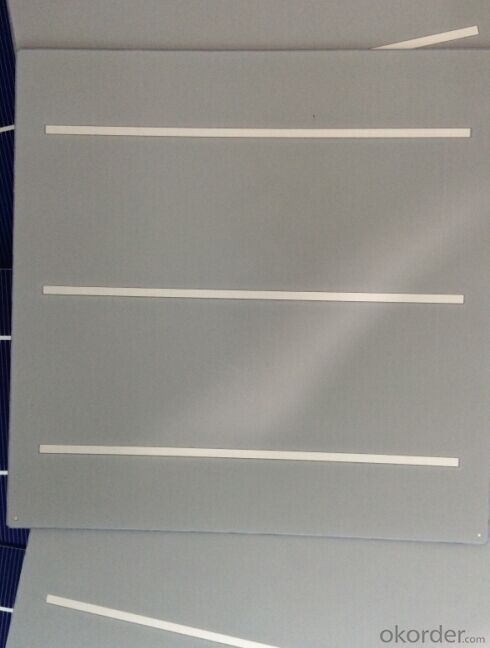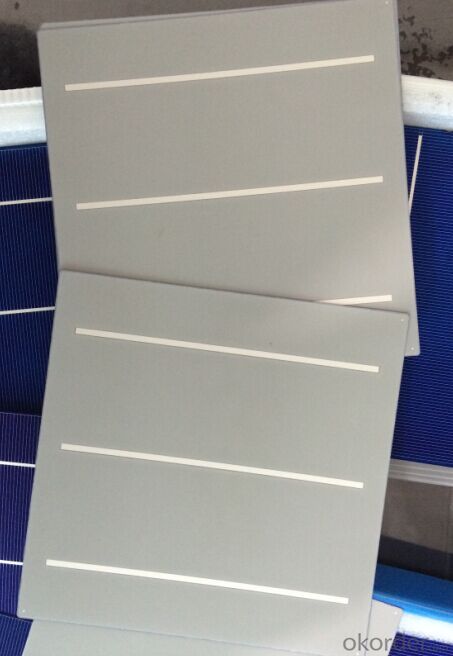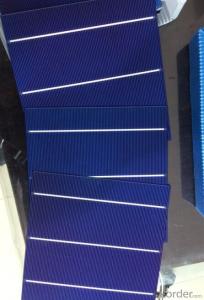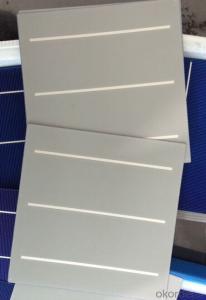Poly Solar Cells Lower than 4Watt Eff Better Price
- Loading Port:
- Shanghai
- Payment Terms:
- TT or LC
- Min Order Qty:
- 30000 pc
- Supply Capability:
- 1000000 pc/month
OKorder Service Pledge
OKorder Financial Service
You Might Also Like
Electrical Characteristic
Efficiency (%) | Pmpp (W) | Umpp (V) | Impp (A) | Uoc (V) | Isc (A) | FF (%) |
17.25 | 4.197 | 0.524 | 7.992 | 0.62 | 8.458 | 80.03% |
17 | 4.137 | 0.524 | 7.876 | 0.619 | 8.353 | 80.01% |
16.75 | 4.076 | 0.522 | 7.81 | 0.617 | 8.286 | 79.73% |
16.5 | 4.015 | 0.518 | 7.746 | 0.613 | 8.215 | 79.73 |
16.25 | 3.955 | 0.515 | 7.683 | 0.61 | 8.144 | 79.61% |
16 | 3.894 | 0.512 | 7.613 | 0.608 | 8.075 | 79.31% |
15.75 | 3.833 | 0.51 | 7.534 | 0.605 | 8.058 | 78.62% |
15.5 | 3.772 | 0.508 | 7.453 | 0.604 | 8.02 | 77.87% |
15.25 | 3.771 | 0.505 | 7.35 | 0.604 | 9.997 | 76.83% |
15 | 3.65 | 0.503 | 7.271 | 0.604 | 7.989 | 75.64% |
14.5 | 3.529 | 0.499 | 7.067 | 0.604 | 7.988 | 73.14% |
14 | 3.407 | 0.499 | 6.833 | 0.604 | 7.833 | 72.01% |
Advantage Of Poly Solar Cell 156mm
1: High quality cell, Level A cell (14%—17.5%)
2.Dimensione:156*156mm Diagonal:200mm
3: Qualified certification: TUV,CE certification.
4: Warranty: five years for whole unit
Usage/Application Of Poly Solar Cell 156mm
Packaging & Delivery Of Poly Solar Cell 156mm | |
Packaging Detai | Packaging Detail:Export Carton and Pallet or under customer request. |
Delivery Detail:10-20days | |


Solar cells are typically named after the semiconducting material they are made of. These materials must have certain characteristics in order to absorb sunlight. Some cells are designed to handle sunlight that reaches the Earth's surface, while others are optimized for use in space. Solar cells can be made of only one single layer of light-absorbing material (single-junction) or use multiple physical configurations (multi-junctions) to take advantage of various absorption and charge separation mechanisms.
- Q:Can solar cells be used in smart grid systems?
- Yes, solar cells can be used in smart grid systems. Solar cells are a reliable and renewable source of energy that can generate electricity to power smart grids. They can be integrated into the grid infrastructure to provide clean and sustainable energy, reducing dependence on fossil fuels and contributing to the overall efficiency and sustainability of the smart grid system.
- Q:How to explain to students how the solar cells are made?
- You'd better explain it step by step, following the lab experiments.
- Q:How do solar cells perform in regions with high levels of snowfall and blizzards?
- Solar cells generally do not perform optimally in regions with high levels of snowfall and blizzards. The snow accumulation on the solar panels can significantly reduce their ability to generate electricity as it blocks the sunlight from reaching the cells. However, advancements in technology and design have led to the development of snow-resistant solar panels that can shed snow more easily and continue to generate electricity even in snowy conditions. Additionally, the angle and tilt of the panels can also play a role in snow shedding. Overall, while solar cells may not perform at their highest efficiency in regions with heavy snow, it is still possible to generate some electricity with proper installation and maintenance practices.
- Q:How do solar cells perform in areas with high levels of air pollution?
- Solar cells perform less efficiently in areas with high levels of air pollution. Air pollution, especially particulate matter and smog, can block sunlight and reduce the amount of light reaching the solar cells. This reduces their ability to generate electricity and can significantly decrease their performance. Additionally, air pollution can settle on the surface of the solar panels, creating a layer of dirt or dust that further reduces their efficiency. Regular cleaning and maintenance are required to ensure optimal performance in such areas.
- Q:How are solar cells made?
- Solar cells are typically made using a process called photovoltaic (PV) technology, which involves the assembly of semiconductor materials, usually silicon, into thin layers. The silicon is purified and then shaped into wafers, which are then treated with various dopants to create the desired electrical properties. Metal contacts are added to these wafers, and the cells are encapsulated with protective materials. When sunlight hits the cell, the photons from the sunlight create an electric field across the layers, generating electricity.
- Q:My son is very interested in solar cells recently, and keeps asking me about the structure of a solar cell. Can anybody help me answer that question?
- This is what I search online from Wikipedia, solar cell is an electrical device that converts the energy of light directly into electricity by the photovoltaic effect.
- Q:What is the role of maximum power point tracking in solar cell systems?
- The role of maximum power point tracking (MPPT) in solar cell systems is to optimize the energy output of the solar cells. It does this by continuously adjusting the operating voltage and current of the solar cells to find the maximum power point, where the solar cells are operating at their highest efficiency. MPPT ensures that the solar cells are always delivering the maximum amount of power to the system, resulting in improved energy generation and increased overall system performance.
- Q:How do solar cells perform in areas with extreme temperature fluctuations?
- Solar cells typically perform well in areas with extreme temperature fluctuations. However, excessive heat can slightly reduce their efficiency, while extreme cold can temporarily decrease their power output. Nonetheless, solar cells are designed to withstand a wide range of temperatures, and advancements in technology have improved their performance and durability in extreme weather conditions.
- Q:Why should the solar cells be laserized?
- While the P2, P3 level with green nano-laser is the most ideal. In the actual experiment process using green picosecond laser technology the best, but taking into account the cost of equipment into the point of view, green nanosecond most ideal
- Q:What is the impact of hailstorms on solar cells?
- Hailstorms can have a detrimental impact on solar cells. The physical impact of hailstones can cause cracks or shattering of the solar panels, leading to reduced efficiency or complete failure of the cells. Additionally, the protective layers of the solar panels can be damaged, making them more susceptible to moisture intrusion and corrosion. Overall, hailstorms pose a significant risk to the durability and performance of solar cells.
1. Manufacturer Overview |
|
|---|---|
| Location | |
| Year Established | |
| Annual Output Value | |
| Main Markets | |
| Company Certifications | |
2. Manufacturer Certificates |
|
|---|---|
| a) Certification Name | |
| Range | |
| Reference | |
| Validity Period | |
3. Manufacturer Capability |
|
|---|---|
| a)Trade Capacity | |
| Nearest Port | |
| Export Percentage | |
| No.of Employees in Trade Department | |
| Language Spoken: | |
| b)Factory Information | |
| Factory Size: | |
| No. of Production Lines | |
| Contract Manufacturing | |
| Product Price Range | |
Send your message to us
Poly Solar Cells Lower than 4Watt Eff Better Price
- Loading Port:
- Shanghai
- Payment Terms:
- TT or LC
- Min Order Qty:
- 30000 pc
- Supply Capability:
- 1000000 pc/month
OKorder Service Pledge
OKorder Financial Service
Similar products
New products
Hot products
Hot Searches
Related keywords



























